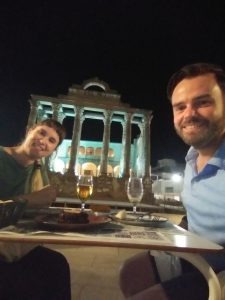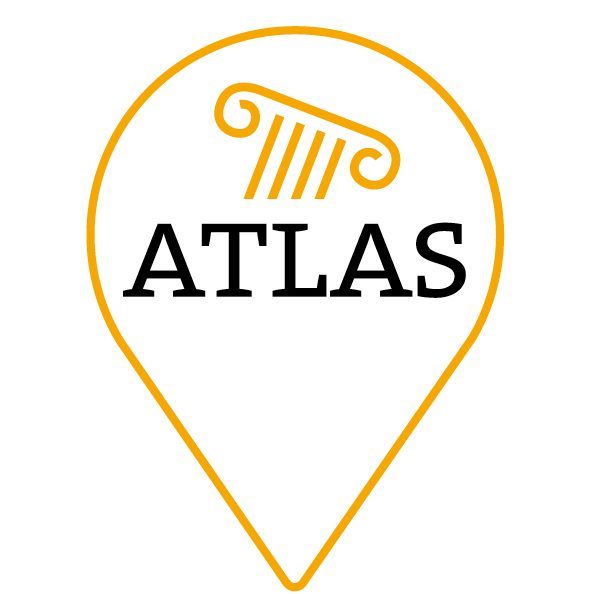Despite the silent and calm summer we have been continuing our work on the ATLAS project, but at a slower pace. To speed up our work on the current case study, Mérida, we decided to visit it and get a feel of the Rome of Hispania, as Schulten called it. This visit provided us with several opportunities. First and foremost get in touch with the latest work done in the field of Late Antique Mérida and meeting with the experts and team members in Mérida.
However, one does not simply walk into Mérida. First the Hamburg team, Sabine and Pieter, had to get to Madrid, early flights and all that. From there Ada joined for the train ride between Madrid and Mérida. We learned that digital displays and announcements are not to be trusted in Ciudad Real. We had to change trains and go to Vía 3, according to our information, the displays and the intercom system. However, personnel told us to go to Vía 4. Waiting at Vía 4 the announcement told us that the train for Mérida was about to arrive in minutes at Vía 3, doubt took over: “What if the man is wrong… We will miss our connection and will have to spend the night at the station of Ciudad Real…” The man was right and all other information proved to be wrong, so we took our train from Vía 4 and made it to Mérida. We were really in the inland of Spain. As we moved more inland the outside temperature only rose, even though time passed and the evening had started… Arriving at Mérida in the early evening we were treated to the magnificent view of the so-called Templo de Diana.
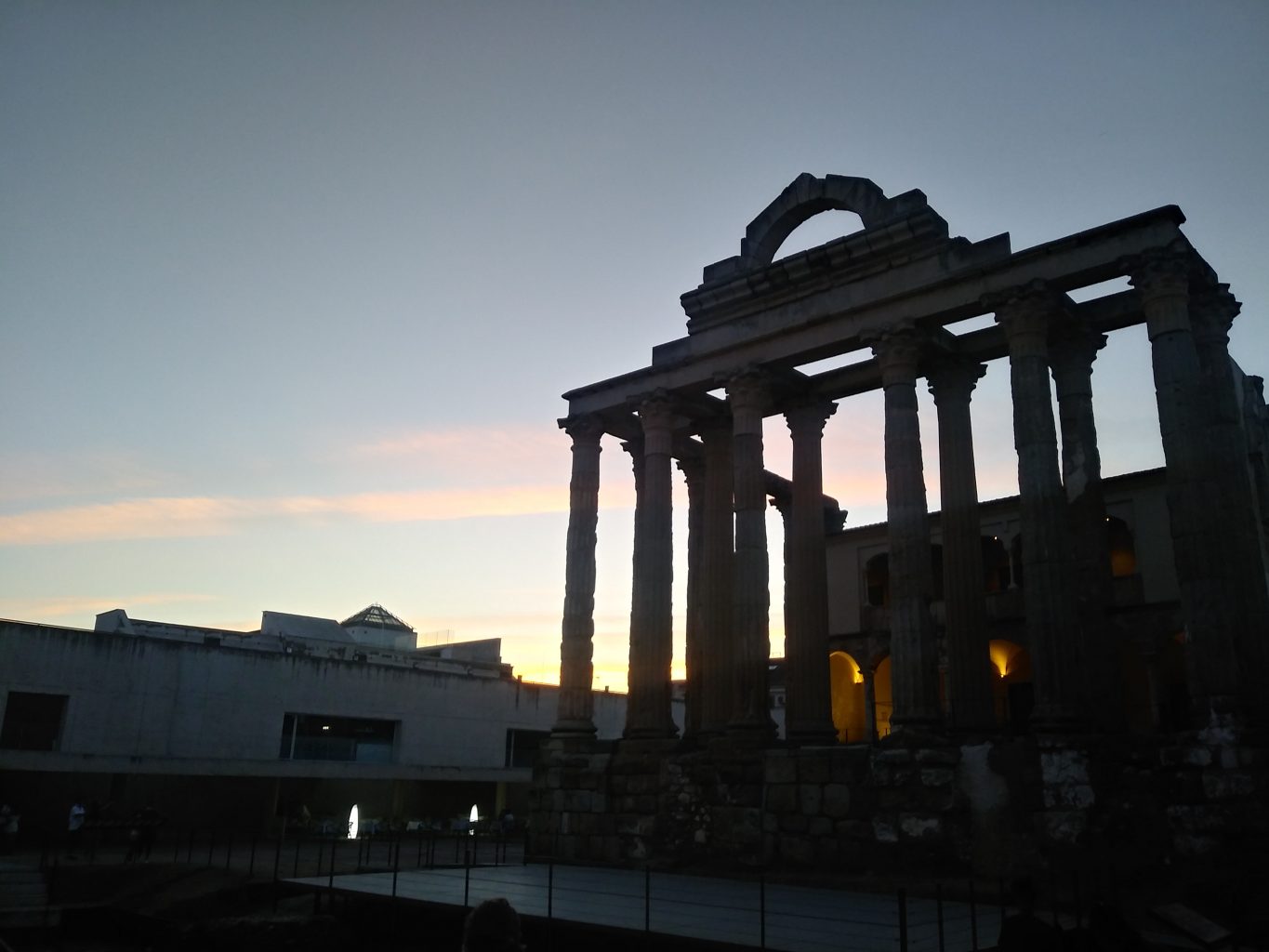
Tuesday first full day in Mérida
The omens were aligning on Tuesday, that morning the birds flew the right path. By chance we chose the restaurant next to the Instituto Arqueológico de Mérida (IAM) headquarters for breakfast. The IAM director, and ATLAS member, Pedro Mateos found us enjoying breakfast while entering his office. After discussing research topics over a café con leche, he gave us a tour of the most important sites.
We started with one of his favourites: Santa Eulalia, which he excavated between the 80’s and 90’s. We immediately had some interesting discussions on topics. A very relevant topic was how to bring together and interpret the main sources: archaeology, epigraphy and the written Lives of the Saints? These three seem to support each other for some parts, but what about the other parts? We will have to turn to this in the next few years.
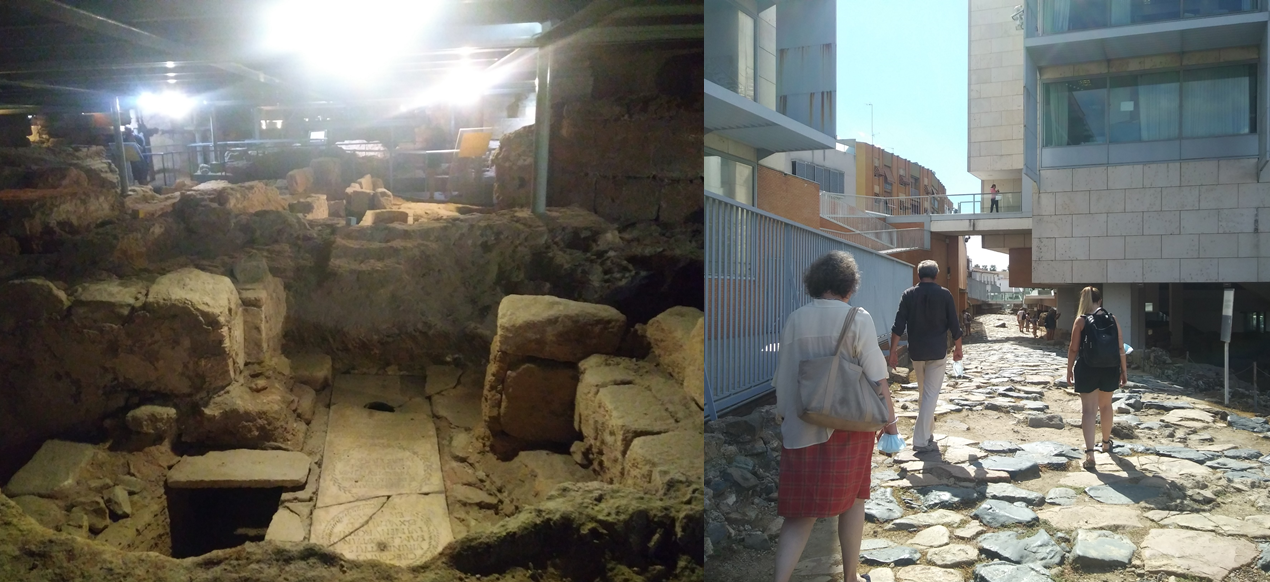
Having such a great guide we were able to visit the latest excavations: a building from the 5th century that is located in the colonial forum. The local archaeologist Rocío Ayerbe showed us around the site and gave some early interpretations of the complex site. When looking at these excavations one wishes the city was in a green field. But then some of the buildings would not have been preserved as well as they have now. One of these buildings we have seen just now, the temple at the colonial forum. We visited this site with Rocío and Pedro to look at the often overseen foundations of another late antique building adjacent to the temple. As usual in many other cities, in late antiquity the forum plaza had been overbuilt. Rocío had to leave us and we moved through the city with Pedro. He gave us a tour of the Morería underneath the building of the Junta de Extremadura at the ancient walls of Emerita. This archaeological site holds a road crossing and some houses. We turned our attention to the reoccupation and reorganisation in later periods. A large domus from the early imperial period was carved up in smaller houses and iron smelting areas. The tour continued to the imperial temple where an interesting inscription was found for the joy of the epigraphists in the group.
This extensive visit by the hand of our colleague aroused our interest in late-antique Mérida even more and after saying goodbye to Pedro we headed for the National Museum of Roman Art (MNAR). Fortune smiled on us again as we were able to enjoy a full tour of the museum from its director, Trinidad Nogales, who was just finishing the details of an exhibition in Santa Cruz de Tenerife opening the next day. So, as we told you on Twitter, we were able to stop and take in one of the many interesting inscriptions that the museum preserves, such as the long epigraph that informs us of the restoration of the circus between 337 and 340. But we were also able to discover the museum’s fantastic library, to which we hope to be able to return and consult its extensive collection very soon. For now, Trinidad offered us a small sample with the gift of several books that will undoubtedly be of great help to us in our project.

On leaving the museum, Pedro had prepared a surprise meeting for us with the Consorcio Ciudad Monumental de Mérida in what we consider to be the best restaurant in Mérida (an opinion supported by gastronomic professionals), located next to the so-called Arch of Trajan: A de Arco. We met Félix Palmer with whom we discussed the objectives and proposals of our project and who was kind enough to make sure that we could visit the different monuments managed by the Consorcio. We finished the meeting quite late and decided to stay for lunch in the same restaurant and what a discovery! We enjoyed a fantastic meal and some delicious desserts, special mention for the chocolate cake!
The Day of Extremadura
On Wednesday, after finding several cafés closed, we headed back to the restaurant where we had breakfast the day before. Mental note for the future: it is important to check regional and local festivities before organising a trip… It turned out that it was the Day of Extremadura and, of course, many businesses were closed. Luckily, the museums and monuments were open so we started that morning by visiting the Visigoth Collection of the MNAR. Although it is a small exhibition, the truth is that they have very interesting pieces that show the monumentality of Visigothic Mérida. It’s a pity that, despite asking for it and looking for it in several places, we couldn’t get hold of the publication of the catalogue… We’ll keep an eye out for the publication of the new edition!
Our tour continued and we went further into the history of Mérida with a visit to the Alcazaba. Most of this part of Late Antique Mérida is a bit too late for us, but it holds some very nice elements of the period between the third and eighth century. It starts with the perimetral walls of the city. These early Roman walls were reinforced in the Visigothic period and later the material was used to create the Alcazaba in the ninth century. One of the constructions using spolia from the visigothic period is the central tower with aljibe (cistern). The tower has an ingenious system to provide water in case of a siege. Inside we find a stairs going down below the water level of the Guadalquivir (in Arabic al-Wādī al-kabīr) passing in front of the base of the Alcazaba wall, positioned on the old Roman dike. Due to water pressure the Guadalquivir water is pushed through the sand and get filtered before entering the cistern (see image).
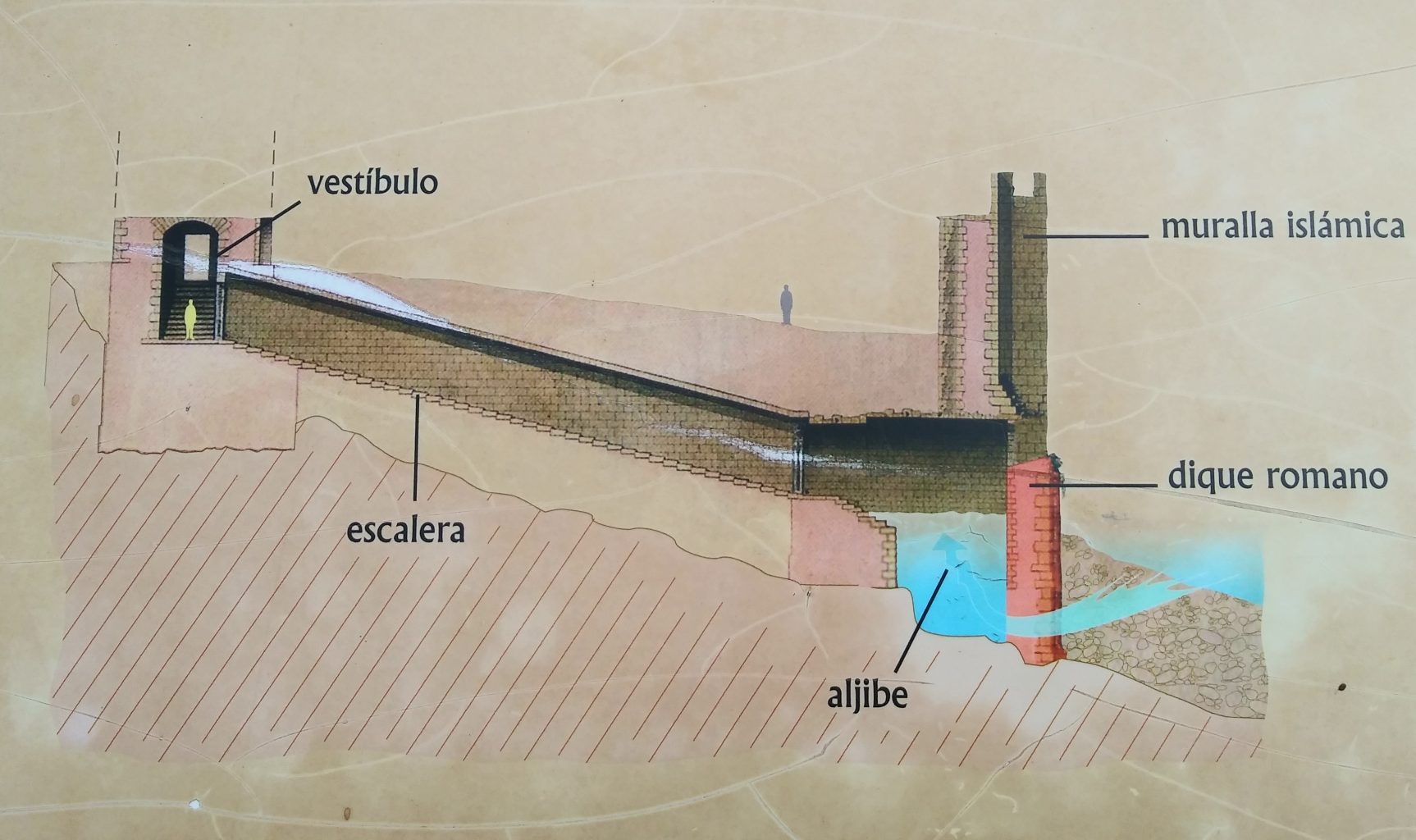

Of course what drew our attention is the use of Visigothic capitals in the construction of the Aljibe. Especially the location in the more secluded parts did puzzle us. Why use such nicely carved columns in sections where not many can appreciate them? Some of us were disturbed more by the asymmetric use of the spolia. The Alcazaba proved to hold more than only some spolia of our period. However, as so often the Late Antique period is slightly forgotten. There is a domus that definitely needs some research. Looking forward to dive into this area of Mérida.
In the late afternoon Jesús García, one of Pieter’s friends and researcher of the IAM, was so kind as to offer us a ride to some sites in the territory of Mérida. After a rather interesting drive along back roads and what seemed nothing more than a dirt road created by tractors, we arrived at the palaeochristian basilica known as Casa Herrera. However, Fortune did not smile upon us that time, Casa Herrera was Casa Cerrada. Well-fenced and well-locked we could only gaze upon the standing columns in the distance. No despair, Jesús knows the lands like the back of his palm and continued the back roads towards the maintenance channels of the aqueduct Los Milagros. From there it was a rather pleasant drive along asphalted roads, oh the joys of modernity, to the Roman Prosperina dam feeding the aqueduct from its reservoir. With the sun setting we sat along its beaches (well not all agreed on whether this can be considered beaches) and had a great dinner enjoying the views over the reservoir.
Last day in Mérida
Our last day started with making up for a mistake made. Taking a picture of the inscriptions at the entrance of the Sta Eulalia:
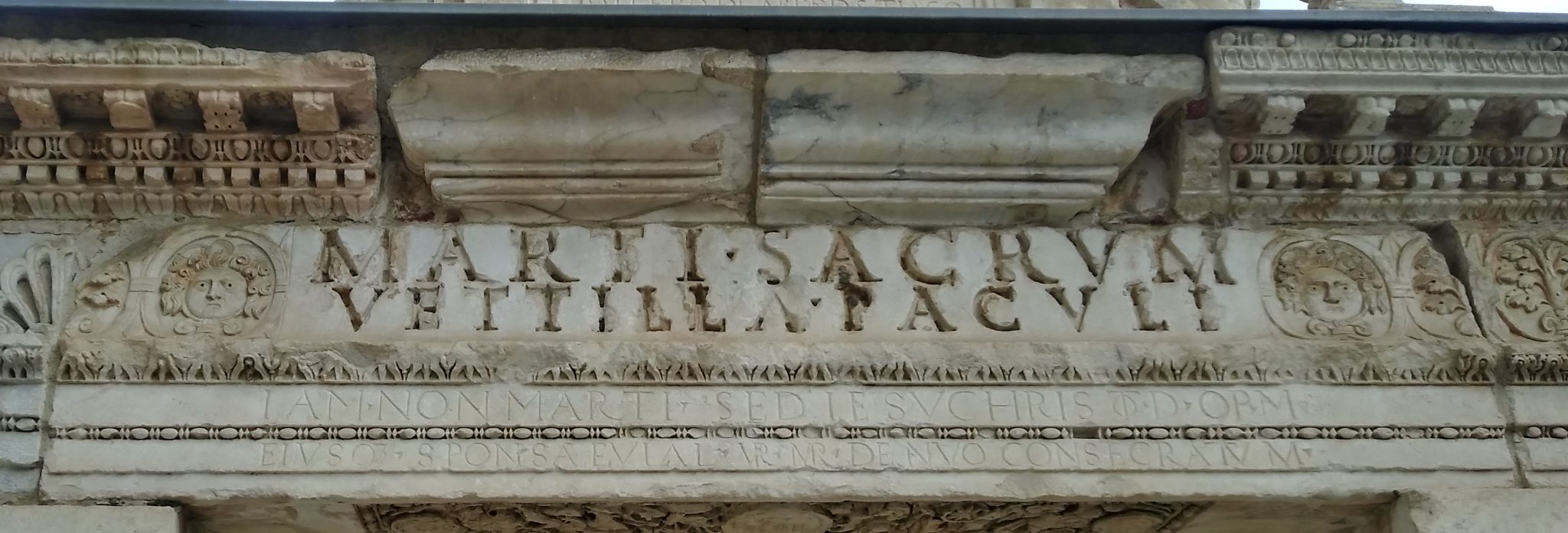
Marti · sacrum
Vettilla · Paculi
Iam non Marti, sed Iesu Christo D.O.M.
eiusque sponsae Eulaliae Vir. Mart. denuo consecratum
The inscriptions are rather interesting, the upper one is a second century dedication to Mars by Vettilla of Paculus. The second one is a reconsecration written in a later period, translated:
Now not to Mars, but to Jesus Christ, God Omnipotent and Merciful, and his spouse Eulalia virgin martyr, consecrated anew.
After taking the pictures we continued to the Xenodochium, which we already mentioned last July. It is here that we saw the reconstructions of some of the columns from the Visigothic Museum and the context started to make sense. Again it was clear to us that the late antique period has ample to offer, but has not received the attention it deserves. We will try our best to make late antique Mérida shine a bit brighter.
Our tour of the city then continued by visiting some of the elite houses. First stop was the Casa de Anfiteatro. Thinking we were visiting an early Roman domus, we were up for a surprise. This domus continued well into the third century and thereby enters our research period. Near the domus some mausolea were found, among them one of the most famous: the Mausoleum of the Rivers. The entrance of the mausoleum held an inscription with depictions of the two rivers Anas (Guadalquivir) and Barraeca (Albarregas). From there we visited another domus constructed in the early imperial period, the Casa Mitreo. This time we were prepared that the domus would have continued into our period. However, it would not be Mérida if we were not surprised by what has been preserved. Here we stood eye in eye with the Mosaic of Cosmology, dated to the fourth century. Those following us on Twitter will know that this one is up for a #MosaicMonday.
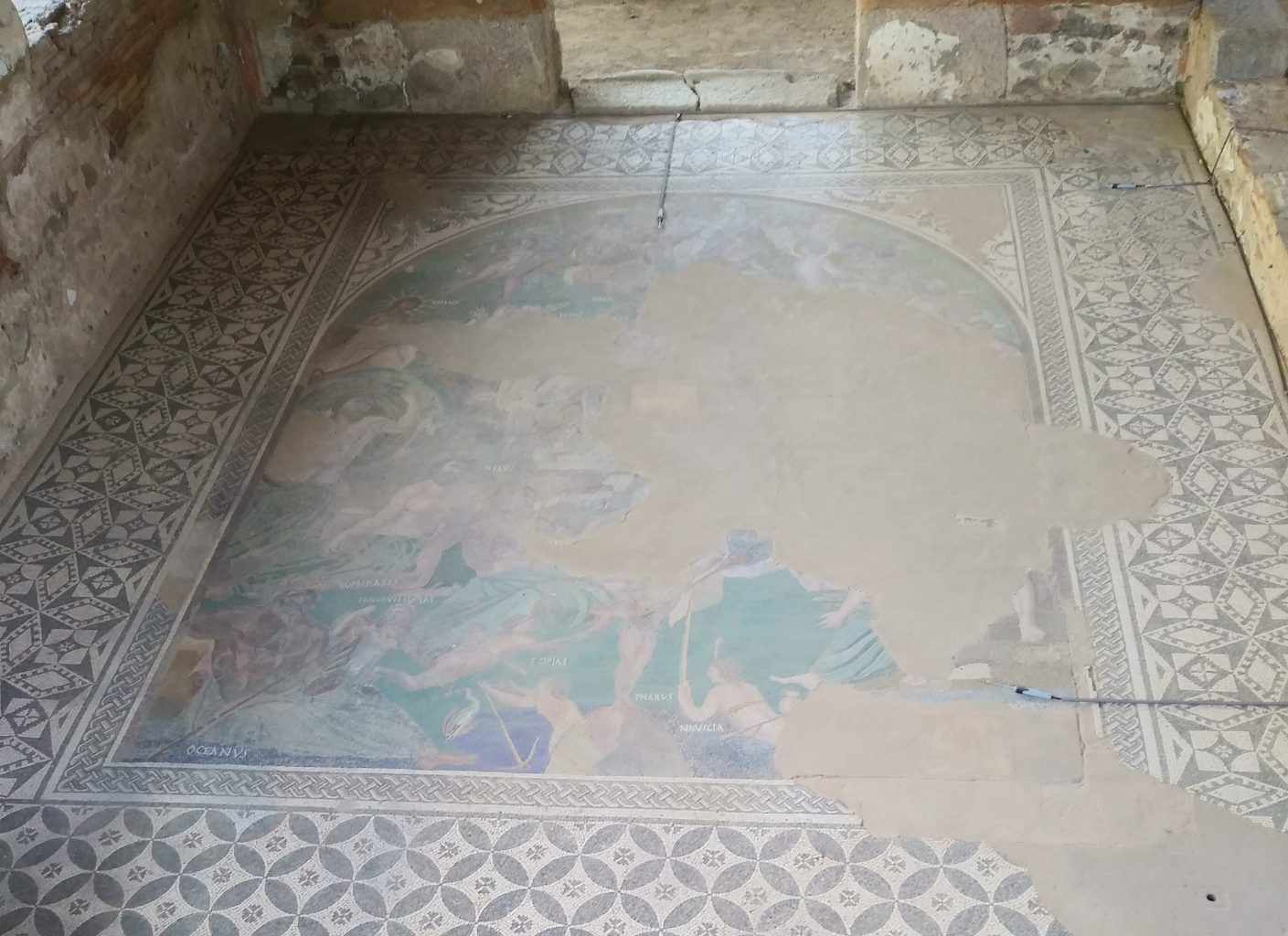
After this tour it was time for lunch. And as three times is a charm, we went back for more joy at our preferred lunch venue. During our lunch we discussed the plan for the afternoon, including going back to the hotel to do less fun work. Let’s be honest, visiting archaeological sites and museums is fun and joyful, even though it does count as work for us. After the lunch and work break we continued our archaeological tour of Mérida. With a visit to the theatre and amphitheatre. These two buildings were excavated in the early 20th century, with a clear focus on the earliest phase of the buildings. As so often the archaeological layers of late antiquity were only a nuisance that needed to be cleared to get to the earlier layers. As a result only little is known about the late antique use of these buildings. Interestingly there is some evidence for late antique use of the amphitheatre, which we found in one of the books gifted on the first day!
To make our trip a full circle we decided to have the last dinner at the first magnificent view: under the columns of the temple of Diana. We had a spot exactly in front of the temple and enjoyed a nice evening recollecting what we had seen and done. The next few weeks we will continue our literature study of Mérida, but now with clear pictures of the sites and epigraphy in our mind.
